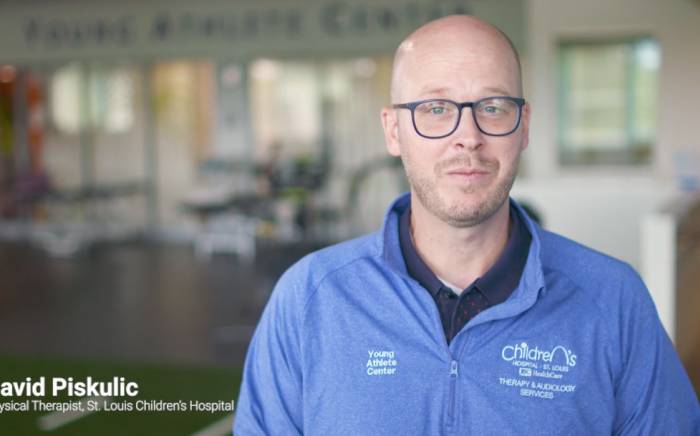Overview
Tetralogy of Fallot (TOF) is a group of 4 congenital heart defects. This means that your child is born with them. These 4 problems occur together (tetralogy refers to 4). They are:
- Narrowing (stenosis) of the pulmonary artery. The pulmonary artery carries blood from the heart to the lungs for oxygen.
- Ventricular septal defect. This is an opening in the wall between the 2 lower chambers of the heart (right and left ventricles).
- Overriding aorta. The artery that carries oxygen-rich blood to the body (aorta) is shifted toward the right side of the heart. It should be on the left side. In this condition, the aorta sits over the ventricular septal defect.
- Hypertrophy (enlargement) of the right ventricle. The right lower chamber of the heart (ventricle) is bigger than normal.
For more information regarding pediatric TOF services in St. Louis or to make an appointment, please call 314.454.5437 or 800.678.5437 or email us.
In a healthy heart, oxygen-poor (blue) blood returns to the right chamber of the heart (right atrium) from the body. Next, it travels through the tricuspid valve to the right ventricle of the heart. Then it’s pumped through the pulmonary valve to the pulmonary artery and into the lungs for oxygen. Oxygen-rich (red) blood comes back to the left upper chamber of the heart (left atrium) from the lungs. Then it passes through the mitral valve and into the left ventricle of the heart. Finally, it’s pumped through the aortic valve to the aorta and out to the body.
Some children with TOF may only have slightly lower than normal oxygen levels in their blood. These children don’t usually have bluish skin (cyanosis). Other children with TOF will have low oxygen levels in their blood. These children have bluish skin. This is from the low oxygen levels in their blood.
Causes
Genes and family history may play a part in TOF. It may also be caused by Down syndrome or 22q11.2 deletion syndrome (DiGeorge syndrome). Most of the time, this heart defect occurs by chance, with no cause.
Symptoms
Symptoms can occur a bit differently in each child. The most common symptom is a blue color of the skin, lips, and nail beds. This may come in sudden spells, called TET spells. It happens when a baby's blood oxygen level drops quickly. During the spell, babies may have a hard time breathing. They may also be tired and fussy. In the most extreme circumstances, they may lose consciousness.
The symptoms of TOF may be similar to symptoms caused by other problems. Make sure that your child sees a healthcare provider for a diagnosis.
For more information regarding pediatric TOF services in St. Louis or to make an appointment, please call 314.454.5437 or 800.678.5437 or email us.
Diagnosis
A healthcare provider may first spot this condition in a baby during an ultrasound in pregnancy. Or your child's healthcare provider may suspect this issue when he or she hears an abnormal sound (heart murmur) when listening to your child's heart with a stethoscope. Your provider may refer him or her to a heart doctor for children (pediatric cardiologist).
Your child’s heart doctor will check your baby. He or she will listen to your baby's heart and lungs. The details about your child’s heart murmur will also help the doctor make the diagnosis.
Your child’s doctor may then do tests to confirm the diagnosis. The tests your child has depends on his or her age and condition, and the doctor’s preferences.
Chest X-ray
A chest X-ray may show changes in the heart and lungs caused by tetralogy of Fallot.
Electrocardiogram (ECG)
This test records the electrical activity of the heart. It also shows abnormal rhythms (arrhythmias or dysrhythmias) and spots heart muscle stress. These issues may be caused by caused by tetralogy of Fallot.
Echocardiogram (echo)
An echo uses sound waves to make a moving picture of the heart and heart valves. This test may show structural changes caused by tetralogy of Fallot.
Cardiac catheterization (cardiac or heart cath)
A cardiac catheterization gives detailed information about the structures inside the heart. In this test, a small, thin, flexible tube (catheter) is put into a blood vessel in your child’s groin. Then the healthcare provider guides it to your child’s heart. Your child’s healthcare provider will inject your child with contrast dye to see his or her heart more clearly. This test measures your child’s blood pressure and oxygen in the 4 chambers of the heart. It also measures blood pressure and oxygen in the pulmonary artery and aorta. Your child will get medicine to help relax and prevent pain (sedation).
Treatment
Treatment will depend on your child’s symptoms, age, and general health. It will also depend on how severe the condition is.
Some children will need a shunt implanted to provide stable pulmonary blood flow until a more permanent repair can be made a later age.
All children with tetralogy of Fallot need to have surgery to fix it. Most children have it before they turn 1 year old. It’s often done around 6 months of age. A team of heart surgeons will do your child’s surgery.
To fix TOF your doctor may use a patch to close ventricle septal defect (VSD). Enlarging the right ventricular outflow tract can be done by relieving pulmonary stenosis, and possibly using a patch to enlarge the pulmonary arteries if there is narrowing.
Fixing the heart defects will allow oxygen-poor blood to travel its normal route which is through the pulmonary artery to the lungs to pick up oxygen.
Complications
This condition often doesn’t cause complications. If left untreated, it can cause these problems:
- Blood clots (which may be in the brain causing stroke)
- Infection in the lining of the heart and heart valves (bacterial endocarditis)
- Heart failure
- Death
Living with
After surgery, your child may become tired easily and sleep more. Eventually, most children are able to be active. Children’s activity levels, appetite, and growth become normal soon after surgery. But, some children who had surgery for TOF can have problems learning or growing normally.
Your child's heart doctor may give him or her antibiotics to prevent infections after leaving the hospital. Your child may also need medicine before other surgeries or dental tests.
Most children who have surgery for this condition will live healthy lives. They may need a pulmonary valve replacement surgery when they are adults. This will help prevent heart complications. These include enlargement of the right ventricle, abnormal heart rhythms, and heart failure. Women who want to have children should be checked by a heart doctor before they get pregnant.
Ask your child's healthcare provider about your child’s outlook.
When to Call a Healthcare Provider
Call your child’s healthcare provider if he or she has trouble breathing, eating, or being active.
Key Points
- Tetralogy of Fallot is 4 congenital heart defects. Children are born with this condition.
- This condition gets in the way of the heart’s ability to pump oxygen-rich blood to the body.
- All children with tetralogy of Fallot need to have surgery to fix it.
- After surgery, most children will live healthy lives.
- Most children who have had surgery for TOF will need additional surgical or interventional procedures in adulthood.
Next Steps
Tips to help you get the most from a visit to your child’s healthcare provider:
- Know the reason for the visit and what you want to happen.
- Before your visit, write down questions you want answered.
- At the visit, write down the name of a new diagnosis, and any new medicines, treatments, or tests. Also write down any new instructions your provider gives you for your child.
- Know why a new medicine or treatment is prescribed and how it will help your child. Also know what the side effects are.
- Ask if your child’s condition can be treated in other ways.
- Know why a test or procedure is recommended and what the results could mean.
- Know what to expect if your child does not take the medicine or have the test or procedure.
- If your child has a follow-up appointment, write down the date, time, and purpose for that visit.
- Know how you can contact your child’s provider after office hours. This is important if your child becomes ill and you have questions or need advice.
For more information regarding pediatric TOF services in St. Louis or to make an appointment, please call 314.454.5437 or 800.678.5437 or email us.








